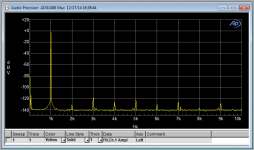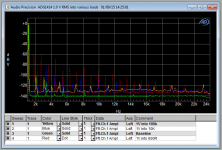I see no reason why not. The on resistance is lower than typical IC packages of the 4016/66 variety which is a good point. I suspect you would still get breakthrough due to PCB layout and package issues though, particularly if just using them as a series on/off element feeding into a relatively high impedance node. A couple of JFET's per channel work every bit as well and in a series shunt arrangement working into a virtual earth opamp give essentially total isolation.
Will order a couple -- the NO version is unavailable at DK. Edit -- they have some at Mouser.
Last edited:
...I think the main reason some analog switches need to switch current rather than voltage is primarily because their power supply limits are smaller than typical voltage swings of audio signals.
not to me, I look at the Ron and parasitic C modulations with Vswing - complementary process analog switches show a curve with better properties ~ midway between the rail V, in fact Ron plots show sharp corners near the rails as the channel V gets closer than the device Vgs to either rail V
switching at virtual gnd uses CMOS analog switches in their most linear mode
jack ,
thanks for sharing. that IS lower than I would expect also!
if you don't mind, what were the test conditions of the circuit (load on the switch, signal levels, supply voltage, etc.)?
i have a few of those parts that i haven't used yet; that might be a mistake
🙂
mlloyd1
thanks for sharing. that IS lower than I would expect also!
if you don't mind, what were the test conditions of the circuit (load on the switch, signal levels, supply voltage, etc.)?
i have a few of those parts that i haven't used yet; that might be a mistake
🙂
mlloyd1
Quite some years ago, I built a radio station monitoring and one feed switcher, but I used the -66 ( or similar ) to switch in the summing point of an inverting opamp....
worked very well, - and quiet switching,,
worked very well, - and quiet switching,,
jack ,
if you don't mind, what were the test conditions of the circuit (load on the switch, signal levels, supply voltage, etc.)?
mlloyd1
The load was that of the analyzer -- 100k||100pF with a 1V signal. The switch is on a protoboard Arduino, just parallel loading the inputs -- input and output were 2.2uF polycarbonate caps.
jackinnj:
thx,
mlloyd1
thx,
mlloyd1
The load was that of the analyzer -- 100k||100pF with a 1V signal. The switch is on a protoboard Arduino, just parallel loading the inputs -- input and output were 2.2uF polycarbonate caps.
The load was that of the analyzer -- 100k||100pF with a 1V signal. The switch is on a protoboard Arduino, just parallel loading the inputs -- input and output were 2.2uF polycarbonate caps.
Switch distortion is mitigated when the switch is in series with a high load impedance.
For anyone interested in analog switch distortion, or a couple of techniques to reduce this distortion, I have an article in this quarter's Analog Applications Journal from Texas Instruments: http://www.ti.com/lit/an/slyt612/slyt612.pdf
Interesting article John. I saved a copy a couple of days back from the emailed TI Bulletin to peruse at leisure.
(looking forwards to your distortion test on the active volume control... something I think Bob C would be interested to)
(looking forwards to your distortion test on the active volume control... something I think Bob C would be interested to)
Of course, the other thing to remember is that the switch resistance and non-linear switch resistance are inversely related to the supply voltage.
Of course, the other thing to remember is that the switch resistance and non-linear switch resistance are inversely related to the supply voltage.
It would be interesting to see if bootstrapping the supply voltage with the signal is a viable way to stabilize the on-resistance. This is done inside the IC on some low-distortion switches, but I honestly haven't played with the concept externally. I guess it all depends on whether the gate voltages internally are tied directly to the supply or to some other circuitry.
It would be interesting to see if bootstrapping the supply voltage with the signal is a viable way to stabilize the on-resistance. This is done inside the IC on some low-distortion switches, but I honestly haven't played with the concept externally. I guess it all depends on whether the gate voltages internally are tied directly to the supply or to some other circuitry.
I think Maxim use a charge pump -- although I think it would be rather noisy.
- Status
- Not open for further replies.
- Home
- Source & Line
- Analog Line Level
- Analog switches

